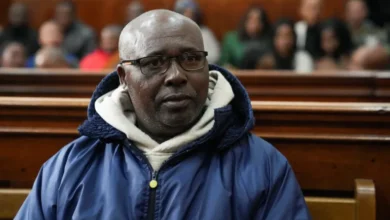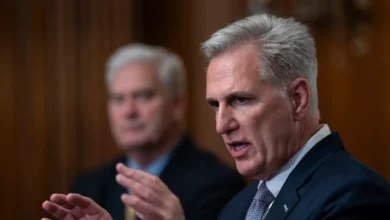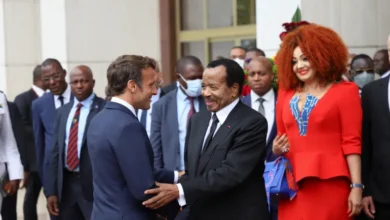New film chronicles century-old Osage Nation murders

The Osage Nation in Oklahoma, like many Native American tribes, has survived colonial oppression, genocide, and the theft of their lands and resources. But a staggering series of murders targeting this community in the 1920s, fuelled by a lust for oil money, has now landed the Osage people in the Hollywood spotlight.
Killers of the Flower Moon, directed by Oscar-winner Martin Scorsese and starring Leonardo DiCaprio, is set to premiere at the Cannes Film Festival on Saturday.
The film chronicles widespread corruption, robbery and murder during an era known as the Reign of Terror. Osage land was rich with oil, bringing wealth to the community — but this prosperity was short-lived, as members were terrorised by dozens of murders orchestrated by white men thirsty for resource rights, known as “headrights”.
The killings started to come to light in 1921, when the decomposed body of Anna Brown, 34, was found in an Osage County ravine. An autopsy revealed she had died of a gunshot wound to the back of the head. Over the next few years, more and more Osage people were found dead under violent or suspicious circumstances.
Dante Biss-Grayson, a member of the Osage Nation, remembers the silence and fear that once permeated his community whenever the topic of headrights came up. His great-great-grandfather, Henry Roan, was murdered in 1923 for his oil money.
“Even when I was growing up, nobody would talk about the headrights,” Biss-Grayson told Al Jazeera. “The whole room would be quiet because they knew it was dangerous … because they knew anyone could be a target.”Shattered by violence
At the height of the Reign of Terror, Osage tribal leaders tasked Barney McBride, a white oilman who they trusted, with going to Washington to plead for help with investigating the murders, as local law enforcement wasn’t solving the crimes and the Osage Nation had limited power.
“Congress had passed laws that broke up our tribal lands, wiped out our tribal government and replaced it with a weak tribal council that had no governmental lawmaking powers, and basically the BIA [Bureau of Indian Affairs] was in charge of everything,” Gray said. “People looked to the tribe for leadership, and they couldn’t do anything to help.”
The murders kick-started the Federal Bureau of Investigation, whose investigation was led by a young agent named Tom White, played in the film by Jesse Plemons, who worked tirelessly to uncover the truth. His efforts paid off; the case was one of the most sensational of the time, with the media following every twist and turn.
But the damage had been done. The Osage were shattered by the violence, and countless families had lost loved ones.Hale, portrayed by Robert De Niro, is thought to have masterminded many of the murders, having married into the Osage community to gain control of oil leases. He hired a hitman to carry out the murders in a plot that involved his nephew, Ernest Burkhart, played by DiCaprio, who married Mollie Kyle (a native Osage, portrayed in the film by Lily Gladstone) at Hale’s urging to gain access to her headrights.Hale was ultimately convicted of Roan’s murder and sentenced to life imprisonment. He was paroled in 1947 after serving only two decades in prison.
Biss-Grayson, a fashion designer who intertwines Osage patterns into his creations, says he often gazes at a well-known photograph of Roan and imagines him at the height of his life. The black-and-white photo features Roan sitting on a large model of a crescent moon, wearing traditional braids, a brimmed hat, a suit and shined shoes.
“To me, he’s kind of jokingly having fun. It feels like a Great Gatsby moment,” Biss-Grayson said. “I try to remember him as if he was in the middle of something. He was in a transition from the old ways to this new world. And then he gets slammed with all his money.
“But I just like to see him in that picture, where he’s smiling and has a little bit of his Native culture, but also in a Western jacket.”
Rights reclaimed
The murders remain a dark stain on United States history. Gray believes the people who were once after the Osage Nation’s wealth didn’t think the Osage people would still be around today.
“It’s probably not out of the realm of possibility that they thought we were going to just die out,” he said. “Given all the killing that was going on, I think it would bring [our ancestors] some joy knowing that we’ve reclaimed our inheritance, and our land, and our stories, and our culture, and our language — and we’re passing them down to our kids. That their lives and their sacrifices are not going to be forgotten.”
Gray named his son, Henry Roan, after his late great-grandfather to ensure his legacy lives on. As former principal chief of the Osage Nation, Gray worked to establish a comprehensive restoration of Osage sovereignty: the right to determine their own citizens and form their own government. He also oversaw the early stages of the Osage Nation buying back parcels of their land.
“If we don’t take control over our tribe, our finances, our story, our government, our future – and quit relying on these entities like the Bureau of Indian Affairs — we’re always going to be victims,” Gray said, noting his efforts were an attempt to “right the ship … We were victims then, during the Reign of Terror, but we don’t live like victims today.”










